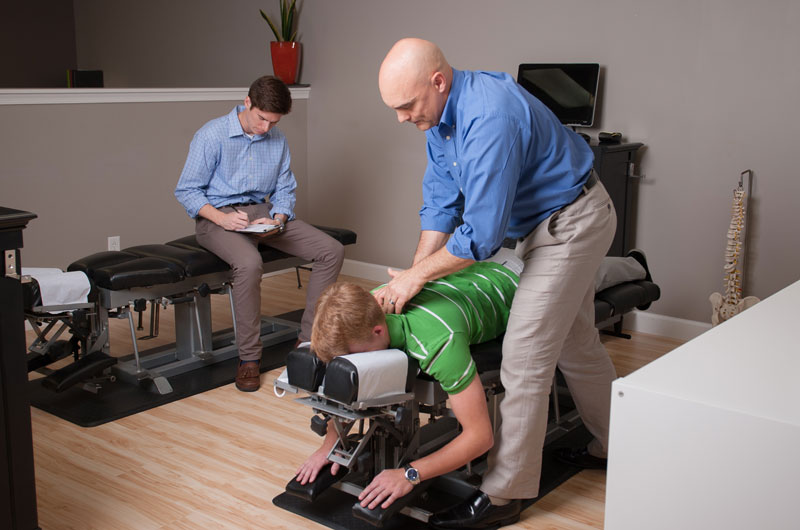I still remember sitting in a waiting area at my first chiropractor’s office and hearing the sound of the adjustment table. Loud banging, an occasional grunt from a patient, the whole thing seemed really…..well, strange to be honest. To make things worse, my first chiropractor had separate rooms for his adjusting tables, so I couldn’t see what was going on. So what is happening over there on the adjusting tables? What will happen when I get my first adjustment?
To ease the nervousness typically associated with starting a new care program, we have put together a quick guide to a first adjustment with us.
Getting Started
After checking in at the front desk, we will ask you to grab a seat for a moment and direct you to an adjusting table as soon as it becomes available. On each visit, 5 things will generally happen:
- The doctor will greet you and do a brief check in with you about how you’re doing, if there’s anything new or different to report, how you are doing on any home therapies, etc.
- The doctor will check your posture
- You will lie on the adjusting table
- The doctor will assess and adjust your spine and any extremities that need attention
- The doctor will do a post-check and give you any necessary recommendations
The first thing you will notice is that we adjust our patients in what is known as “mirror image posture.” Even if you have been to other chiropractors, this is probably different from what you are used to.
A chiropractic adjustment, by its nature, stimulates tiny sensors located in the joints and soft tissues (muscles/tendons/ligaments). These sensors send a barrage of input to the cerebellum during an adjustment. When an adjustment is done in the “mirror image” of your current posture, the result is a “reset” to a posture that is the average of how you normally hold yourself and how we are placing you on the adjusting table.
The second thing you will notice is that we use “drop tables” for our adjustments. Most offices have this type of adjusting table. These tables have sections that are designed to lift up, engage, then drop when pressure is applied to them. When the drop section releases, it makes a bit of noise. Nothing to be alarmed about. In fact, the drops are designed to add comfort to the adjustment.
It is really important to understand that chiropractic care is a process, not an event.
A single chiropractic visit temporarily restores the normal motion and position of the spinal joints and temporarily trains your posture back to normal or near normal. In the beginning of any care plan, the corrections we make to re-train joint function or posture might not last very long—anywhere from a couple of hours to a couple of days is common. A series of chiropractic adjustments is designed to train the mechanical workings of your spine to get out of the way of the electrical functioning of your nervous system. The engineer in me likes to describe it that way.
Chiropractors are very well-trained to detect subtle movements at the joint level and to detect small amounts of swelling or muscle tension around the spine. During the adjustment, we work our way up the spine checking every joint level and correcting what we find. As a care plan progresses, these areas should stabilize and strengthen in their function.
The adjusting process only takes a couple of minutes each time you are on the table. This surprises some people. I even had a medical doctor poke fun at chiropractic a few years ago, saying that nothing effective for health could be accomplished in 3 minutes. The same guy who performs injections in his patients that last 15 seconds. Ironic. I also think the recipient of a shock from a defibrillator might have a word or two on that topic. Suffice it to say that time is not the deciding factor in whether a health procedure is effective.
In contrast to massage therapy or physical therapy, where the therapeutic input requires time to adapt the soft tissues of the body (muscles/tendons/ligaments), a chiropractor’s focus is to change the neurological input from the body. A good analogy is turning on a light switch. There is an instant electrical change when you flip the switch that changes the condition of the room (dark becomes light). An adjustment creates an instant electrical change that changes the condition of your body (better movement, posture, and nerve function).
The “adjustment” in your body actually starts after the adjustment from your chiropractor as the nerves can communicate at a higher level.
Most people stand up after their first adjustment and immediately notice a change in their balance point, stability, freedom of movement, pain level, and posture. Again, this is a temporary change that will become longer lasting with training and time.
It is important to point out here that the activities and movement patterns that you have built into your day are likely continuing during your corrective care process with us. Because of this, we will be giving you something to counteract those daily patterns known as “mirror image exercises.” These exercises will help to balance the way you use your spinal muscles as we correct and stabilize joint function. The result is a spine that can hold its normal posture and moves appropriately. The result of that is better nerve function and therefore better overall health.
One last word about first adjustments before we leave this topic: Soreness. The majority of patients experience a mild soreness from their initial adjustments. This is completely normal. As we train your body to move differently than it is used to, muscles need to adapt to the new movement pattern. This often creates a mild soreness as the muscles stretch and adapt. I call this phenomenon “corrective strain” and tell people to expect it. It is a sign that change is happening and that you are on the road to better health.
Here’s an explanation of post-adjustment soreness from our colleagues at Gonstead Family Practice.
So if you’re ready to get started on your path to better health, set up a new patient appointment right here.

